Client Management Project: CHCCSM004 and CHCCCS019
VerifiedAdded on 2022/08/23
|11
|2892
|15
Project
AI Summary
This assignment presents a comprehensive analysis of client management principles through a project format. It begins with two scenario stages, focusing on active listening, building rapport, and non-judgmental communication with a client facing substance abuse issues and a potentially violent environment due to parental drug abuse. The project then transitions to a case study, examining a counselor's approach to a client (Antonella) with language barriers, emphasizing the importance of interpreter use, informed consent, and the integration of various therapeutic tools. The project also proposes a plan for Tom, a client facing mental health challenges, including the involvement of a social worker, psychiatrist, and psychologist, along with cognitive behavioral therapy, peer support, and professional development programs. It highlights the significance of empathy, flexibility, and cultural sensitivity in counseling, and outlines a twelve-week treatment plan, including progress documentation and confidentiality, while also considering barriers like cost and potential cultural differences. The project underscores the importance of counselor supervision and ongoing professional development to provide effective and ethical care.

Running head: PARAPHRASE
PARAPHRASE
Name of the student
Name of the university
Author Note
PARAPHRASE
Name of the student
Name of the university
Author Note
Paraphrase This Document
Need a fresh take? Get an instant paraphrase of this document with our AI Paraphraser
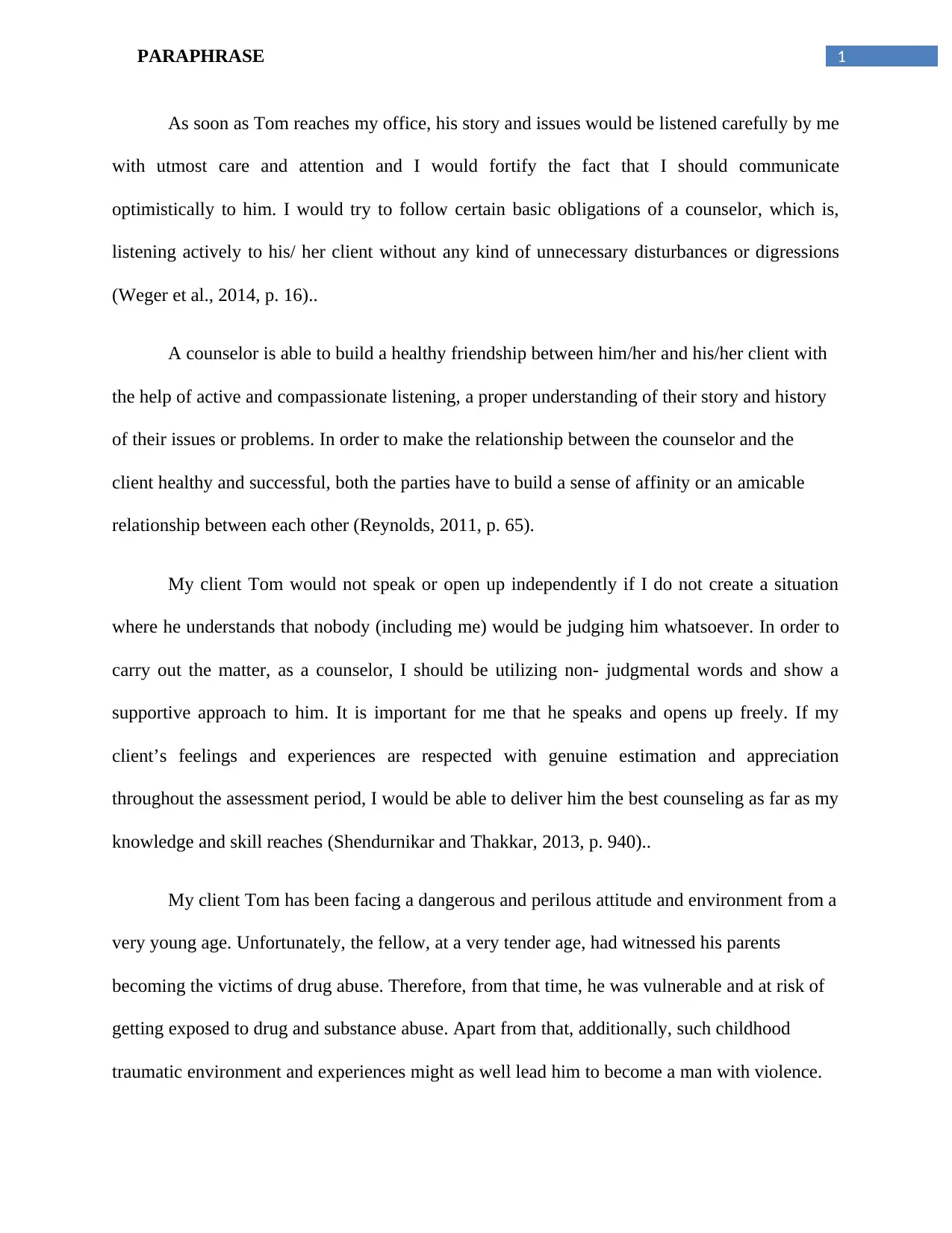
1PARAPHRASE
As soon as Tom reaches my office, his story and issues would be listened carefully by me
with utmost care and attention and I would fortify the fact that I should communicate
optimistically to him. I would try to follow certain basic obligations of a counselor, which is,
listening actively to his/ her client without any kind of unnecessary disturbances or digressions
(Weger et al., 2014, p. 16)..
A counselor is able to build a healthy friendship between him/her and his/her client with
the help of active and compassionate listening, a proper understanding of their story and history
of their issues or problems. In order to make the relationship between the counselor and the
client healthy and successful, both the parties have to build a sense of affinity or an amicable
relationship between each other (Reynolds, 2011, p. 65).
My client Tom would not speak or open up independently if I do not create a situation
where he understands that nobody (including me) would be judging him whatsoever. In order to
carry out the matter, as a counselor, I should be utilizing non- judgmental words and show a
supportive approach to him. It is important for me that he speaks and opens up freely. If my
client’s feelings and experiences are respected with genuine estimation and appreciation
throughout the assessment period, I would be able to deliver him the best counseling as far as my
knowledge and skill reaches (Shendurnikar and Thakkar, 2013, p. 940)..
My client Tom has been facing a dangerous and perilous attitude and environment from a
very young age. Unfortunately, the fellow, at a very tender age, had witnessed his parents
becoming the victims of drug abuse. Therefore, from that time, he was vulnerable and at risk of
getting exposed to drug and substance abuse. Apart from that, additionally, such childhood
traumatic environment and experiences might as well lead him to become a man with violence.
As soon as Tom reaches my office, his story and issues would be listened carefully by me
with utmost care and attention and I would fortify the fact that I should communicate
optimistically to him. I would try to follow certain basic obligations of a counselor, which is,
listening actively to his/ her client without any kind of unnecessary disturbances or digressions
(Weger et al., 2014, p. 16)..
A counselor is able to build a healthy friendship between him/her and his/her client with
the help of active and compassionate listening, a proper understanding of their story and history
of their issues or problems. In order to make the relationship between the counselor and the
client healthy and successful, both the parties have to build a sense of affinity or an amicable
relationship between each other (Reynolds, 2011, p. 65).
My client Tom would not speak or open up independently if I do not create a situation
where he understands that nobody (including me) would be judging him whatsoever. In order to
carry out the matter, as a counselor, I should be utilizing non- judgmental words and show a
supportive approach to him. It is important for me that he speaks and opens up freely. If my
client’s feelings and experiences are respected with genuine estimation and appreciation
throughout the assessment period, I would be able to deliver him the best counseling as far as my
knowledge and skill reaches (Shendurnikar and Thakkar, 2013, p. 940)..
My client Tom has been facing a dangerous and perilous attitude and environment from a
very young age. Unfortunately, the fellow, at a very tender age, had witnessed his parents
becoming the victims of drug abuse. Therefore, from that time, he was vulnerable and at risk of
getting exposed to drug and substance abuse. Apart from that, additionally, such childhood
traumatic environment and experiences might as well lead him to become a man with violence.
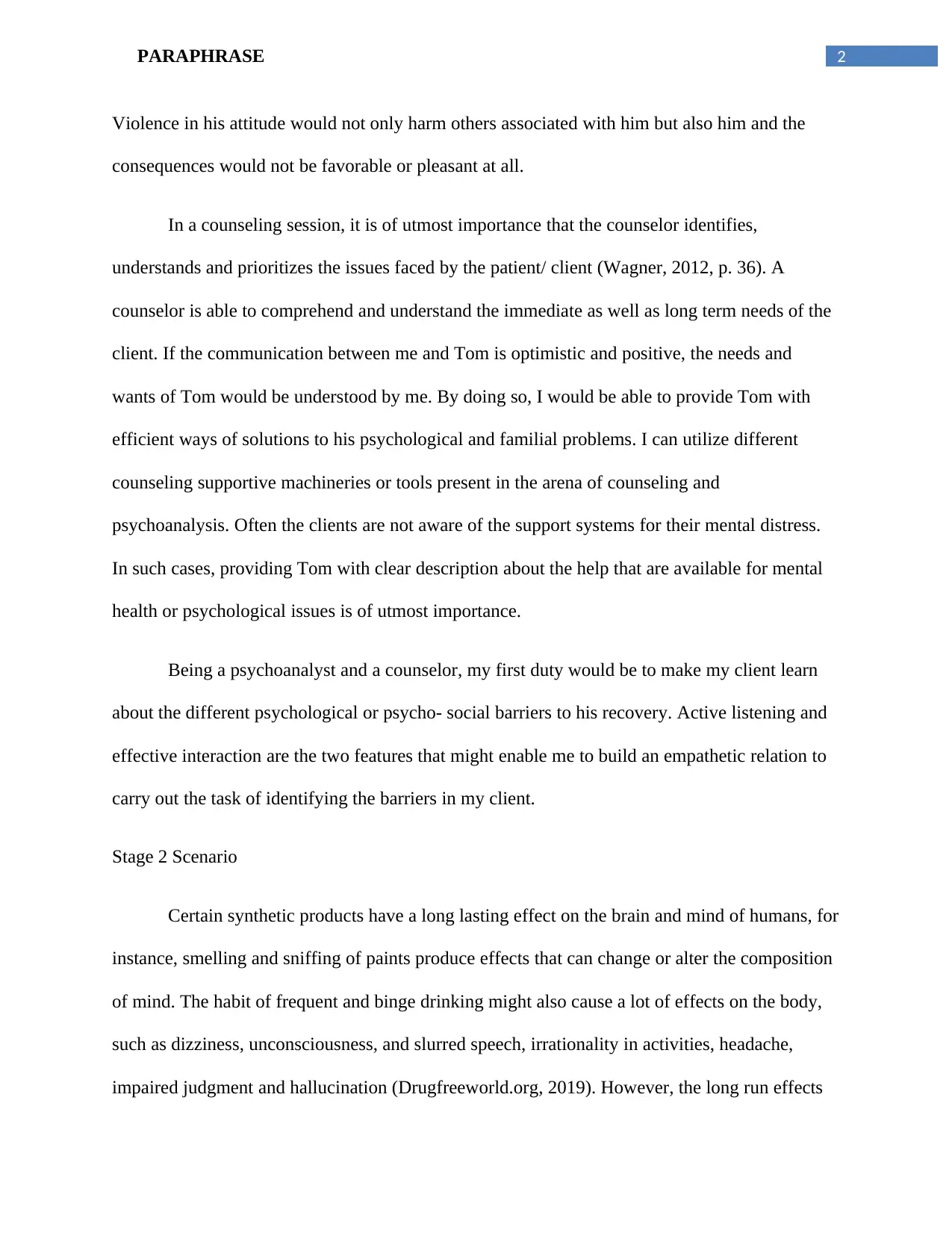
2PARAPHRASE
Violence in his attitude would not only harm others associated with him but also him and the
consequences would not be favorable or pleasant at all.
In a counseling session, it is of utmost importance that the counselor identifies,
understands and prioritizes the issues faced by the patient/ client (Wagner, 2012, p. 36). A
counselor is able to comprehend and understand the immediate as well as long term needs of the
client. If the communication between me and Tom is optimistic and positive, the needs and
wants of Tom would be understood by me. By doing so, I would be able to provide Tom with
efficient ways of solutions to his psychological and familial problems. I can utilize different
counseling supportive machineries or tools present in the arena of counseling and
psychoanalysis. Often the clients are not aware of the support systems for their mental distress.
In such cases, providing Tom with clear description about the help that are available for mental
health or psychological issues is of utmost importance.
Being a psychoanalyst and a counselor, my first duty would be to make my client learn
about the different psychological or psycho- social barriers to his recovery. Active listening and
effective interaction are the two features that might enable me to build an empathetic relation to
carry out the task of identifying the barriers in my client.
Stage 2 Scenario
Certain synthetic products have a long lasting effect on the brain and mind of humans, for
instance, smelling and sniffing of paints produce effects that can change or alter the composition
of mind. The habit of frequent and binge drinking might also cause a lot of effects on the body,
such as dizziness, unconsciousness, and slurred speech, irrationality in activities, headache,
impaired judgment and hallucination (Drugfreeworld.org, 2019). However, the long run effects
Violence in his attitude would not only harm others associated with him but also him and the
consequences would not be favorable or pleasant at all.
In a counseling session, it is of utmost importance that the counselor identifies,
understands and prioritizes the issues faced by the patient/ client (Wagner, 2012, p. 36). A
counselor is able to comprehend and understand the immediate as well as long term needs of the
client. If the communication between me and Tom is optimistic and positive, the needs and
wants of Tom would be understood by me. By doing so, I would be able to provide Tom with
efficient ways of solutions to his psychological and familial problems. I can utilize different
counseling supportive machineries or tools present in the arena of counseling and
psychoanalysis. Often the clients are not aware of the support systems for their mental distress.
In such cases, providing Tom with clear description about the help that are available for mental
health or psychological issues is of utmost importance.
Being a psychoanalyst and a counselor, my first duty would be to make my client learn
about the different psychological or psycho- social barriers to his recovery. Active listening and
effective interaction are the two features that might enable me to build an empathetic relation to
carry out the task of identifying the barriers in my client.
Stage 2 Scenario
Certain synthetic products have a long lasting effect on the brain and mind of humans, for
instance, smelling and sniffing of paints produce effects that can change or alter the composition
of mind. The habit of frequent and binge drinking might also cause a lot of effects on the body,
such as dizziness, unconsciousness, and slurred speech, irrationality in activities, headache,
impaired judgment and hallucination (Drugfreeworld.org, 2019). However, the long run effects
⊘ This is a preview!⊘
Do you want full access?
Subscribe today to unlock all pages.

Trusted by 1+ million students worldwide
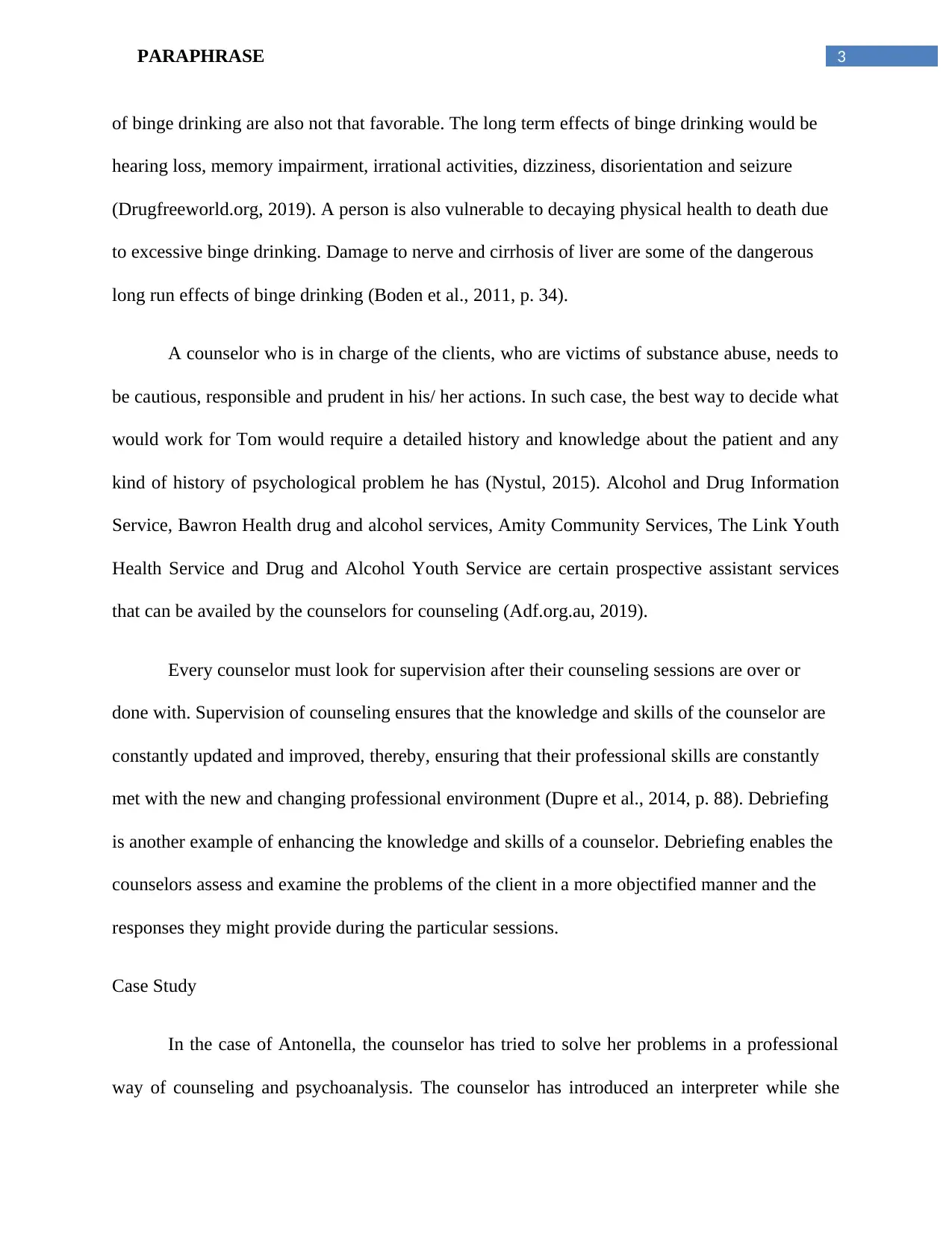
3PARAPHRASE
of binge drinking are also not that favorable. The long term effects of binge drinking would be
hearing loss, memory impairment, irrational activities, dizziness, disorientation and seizure
(Drugfreeworld.org, 2019). A person is also vulnerable to decaying physical health to death due
to excessive binge drinking. Damage to nerve and cirrhosis of liver are some of the dangerous
long run effects of binge drinking (Boden et al., 2011, p. 34).
A counselor who is in charge of the clients, who are victims of substance abuse, needs to
be cautious, responsible and prudent in his/ her actions. In such case, the best way to decide what
would work for Tom would require a detailed history and knowledge about the patient and any
kind of history of psychological problem he has (Nystul, 2015). Alcohol and Drug Information
Service, Bawron Health drug and alcohol services, Amity Community Services, The Link Youth
Health Service and Drug and Alcohol Youth Service are certain prospective assistant services
that can be availed by the counselors for counseling (Adf.org.au, 2019).
Every counselor must look for supervision after their counseling sessions are over or
done with. Supervision of counseling ensures that the knowledge and skills of the counselor are
constantly updated and improved, thereby, ensuring that their professional skills are constantly
met with the new and changing professional environment (Dupre et al., 2014, p. 88). Debriefing
is another example of enhancing the knowledge and skills of a counselor. Debriefing enables the
counselors assess and examine the problems of the client in a more objectified manner and the
responses they might provide during the particular sessions.
Case Study
In the case of Antonella, the counselor has tried to solve her problems in a professional
way of counseling and psychoanalysis. The counselor has introduced an interpreter while she
of binge drinking are also not that favorable. The long term effects of binge drinking would be
hearing loss, memory impairment, irrational activities, dizziness, disorientation and seizure
(Drugfreeworld.org, 2019). A person is also vulnerable to decaying physical health to death due
to excessive binge drinking. Damage to nerve and cirrhosis of liver are some of the dangerous
long run effects of binge drinking (Boden et al., 2011, p. 34).
A counselor who is in charge of the clients, who are victims of substance abuse, needs to
be cautious, responsible and prudent in his/ her actions. In such case, the best way to decide what
would work for Tom would require a detailed history and knowledge about the patient and any
kind of history of psychological problem he has (Nystul, 2015). Alcohol and Drug Information
Service, Bawron Health drug and alcohol services, Amity Community Services, The Link Youth
Health Service and Drug and Alcohol Youth Service are certain prospective assistant services
that can be availed by the counselors for counseling (Adf.org.au, 2019).
Every counselor must look for supervision after their counseling sessions are over or
done with. Supervision of counseling ensures that the knowledge and skills of the counselor are
constantly updated and improved, thereby, ensuring that their professional skills are constantly
met with the new and changing professional environment (Dupre et al., 2014, p. 88). Debriefing
is another example of enhancing the knowledge and skills of a counselor. Debriefing enables the
counselors assess and examine the problems of the client in a more objectified manner and the
responses they might provide during the particular sessions.
Case Study
In the case of Antonella, the counselor has tried to solve her problems in a professional
way of counseling and psychoanalysis. The counselor has introduced an interpreter while she
Paraphrase This Document
Need a fresh take? Get an instant paraphrase of this document with our AI Paraphraser
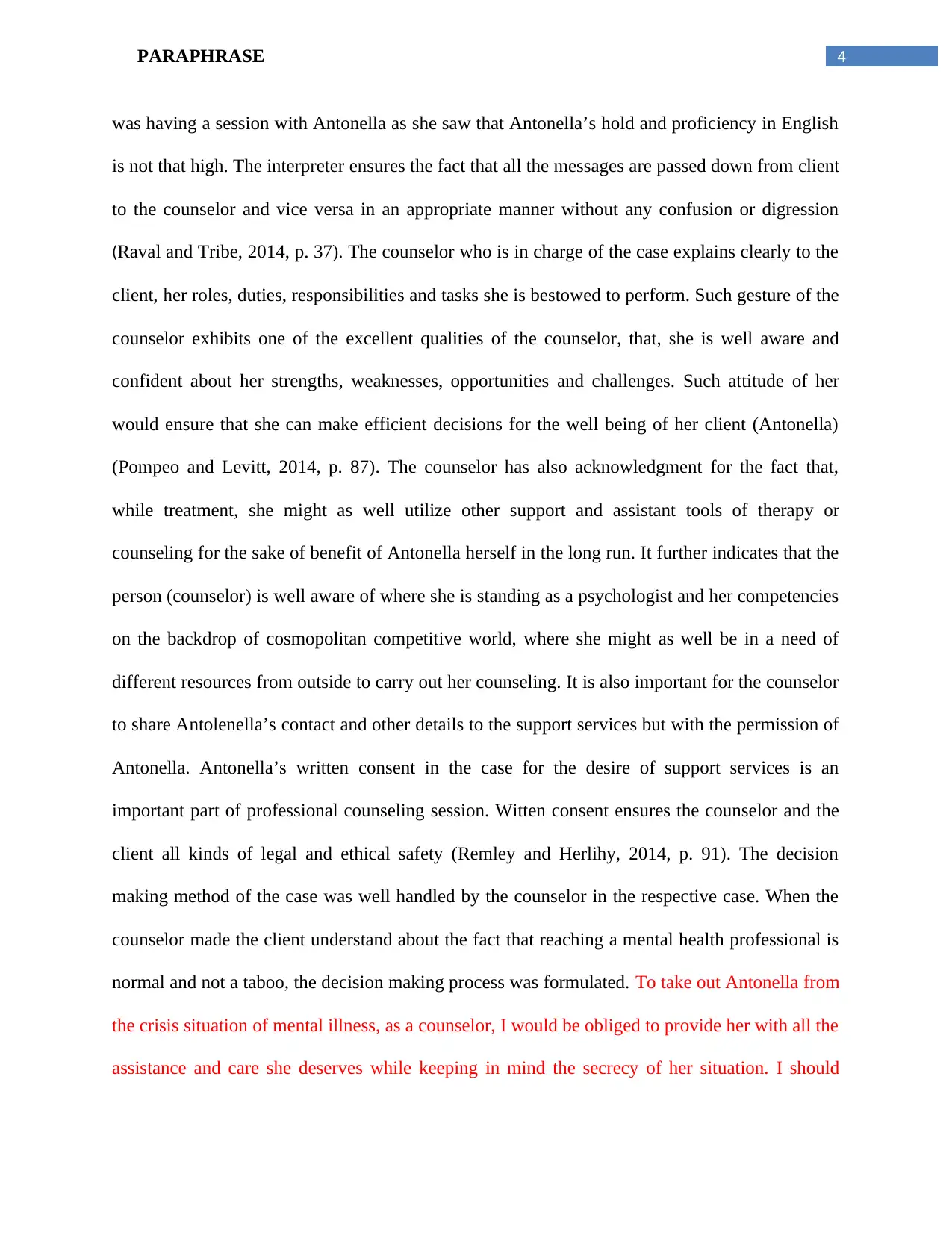
4PARAPHRASE
was having a session with Antonella as she saw that Antonella’s hold and proficiency in English
is not that high. The interpreter ensures the fact that all the messages are passed down from client
to the counselor and vice versa in an appropriate manner without any confusion or digression
(Raval and Tribe, 2014, p. 37). The counselor who is in charge of the case explains clearly to the
client, her roles, duties, responsibilities and tasks she is bestowed to perform. Such gesture of the
counselor exhibits one of the excellent qualities of the counselor, that, she is well aware and
confident about her strengths, weaknesses, opportunities and challenges. Such attitude of her
would ensure that she can make efficient decisions for the well being of her client (Antonella)
(Pompeo and Levitt, 2014, p. 87). The counselor has also acknowledgment for the fact that,
while treatment, she might as well utilize other support and assistant tools of therapy or
counseling for the sake of benefit of Antonella herself in the long run. It further indicates that the
person (counselor) is well aware of where she is standing as a psychologist and her competencies
on the backdrop of cosmopolitan competitive world, where she might as well be in a need of
different resources from outside to carry out her counseling. It is also important for the counselor
to share Antolenella’s contact and other details to the support services but with the permission of
Antonella. Antonella’s written consent in the case for the desire of support services is an
important part of professional counseling session. Witten consent ensures the counselor and the
client all kinds of legal and ethical safety (Remley and Herlihy, 2014, p. 91). The decision
making method of the case was well handled by the counselor in the respective case. When the
counselor made the client understand about the fact that reaching a mental health professional is
normal and not a taboo, the decision making process was formulated. To take out Antonella from
the crisis situation of mental illness, as a counselor, I would be obliged to provide her with all the
assistance and care she deserves while keeping in mind the secrecy of her situation. I should
was having a session with Antonella as she saw that Antonella’s hold and proficiency in English
is not that high. The interpreter ensures the fact that all the messages are passed down from client
to the counselor and vice versa in an appropriate manner without any confusion or digression
(Raval and Tribe, 2014, p. 37). The counselor who is in charge of the case explains clearly to the
client, her roles, duties, responsibilities and tasks she is bestowed to perform. Such gesture of the
counselor exhibits one of the excellent qualities of the counselor, that, she is well aware and
confident about her strengths, weaknesses, opportunities and challenges. Such attitude of her
would ensure that she can make efficient decisions for the well being of her client (Antonella)
(Pompeo and Levitt, 2014, p. 87). The counselor has also acknowledgment for the fact that,
while treatment, she might as well utilize other support and assistant tools of therapy or
counseling for the sake of benefit of Antonella herself in the long run. It further indicates that the
person (counselor) is well aware of where she is standing as a psychologist and her competencies
on the backdrop of cosmopolitan competitive world, where she might as well be in a need of
different resources from outside to carry out her counseling. It is also important for the counselor
to share Antolenella’s contact and other details to the support services but with the permission of
Antonella. Antonella’s written consent in the case for the desire of support services is an
important part of professional counseling session. Witten consent ensures the counselor and the
client all kinds of legal and ethical safety (Remley and Herlihy, 2014, p. 91). The decision
making method of the case was well handled by the counselor in the respective case. When the
counselor made the client understand about the fact that reaching a mental health professional is
normal and not a taboo, the decision making process was formulated. To take out Antonella from
the crisis situation of mental illness, as a counselor, I would be obliged to provide her with all the
assistance and care she deserves while keeping in mind the secrecy of her situation. I should
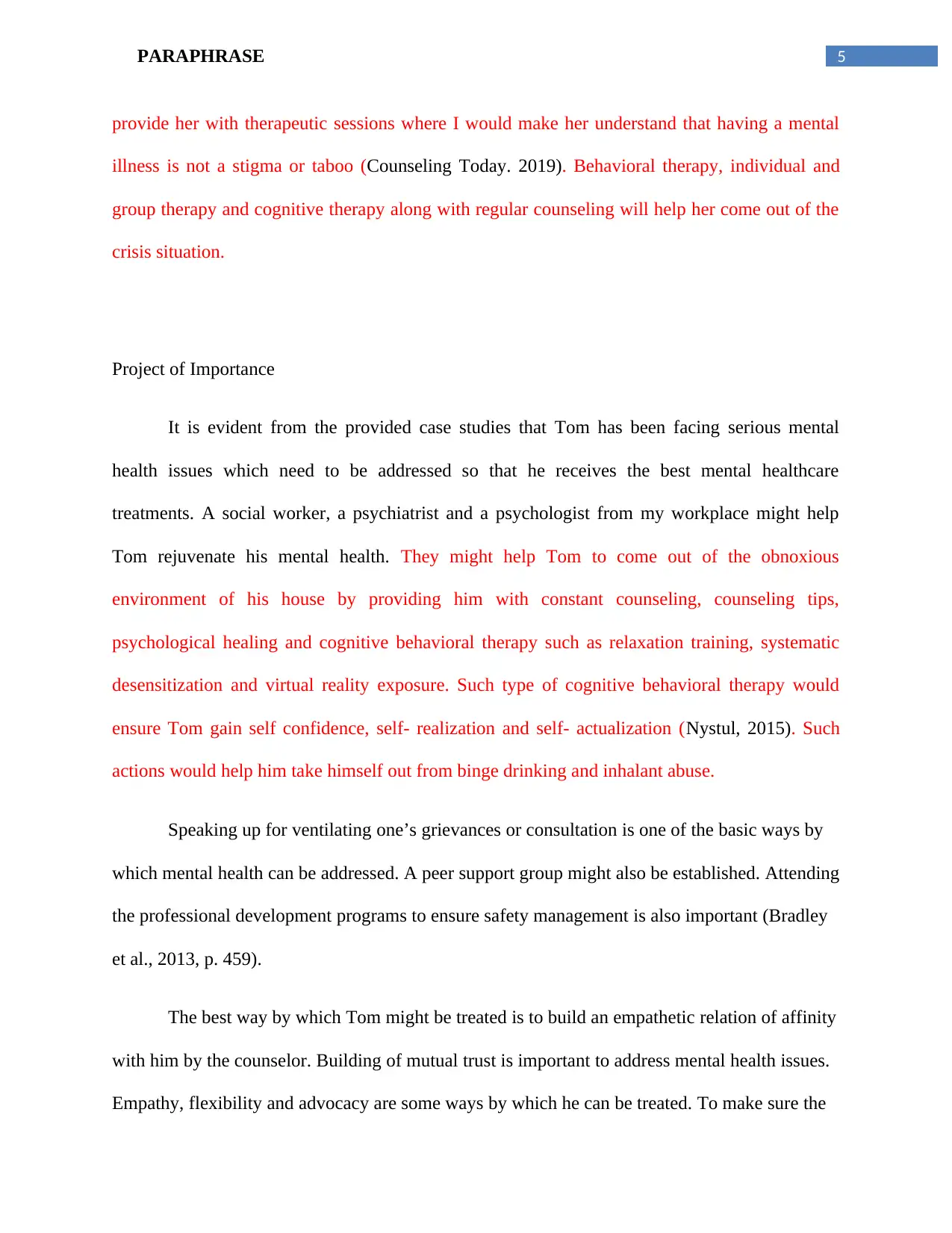
5PARAPHRASE
provide her with therapeutic sessions where I would make her understand that having a mental
illness is not a stigma or taboo (Counseling Today. 2019). Behavioral therapy, individual and
group therapy and cognitive therapy along with regular counseling will help her come out of the
crisis situation.
Project of Importance
It is evident from the provided case studies that Tom has been facing serious mental
health issues which need to be addressed so that he receives the best mental healthcare
treatments. A social worker, a psychiatrist and a psychologist from my workplace might help
Tom rejuvenate his mental health. They might help Tom to come out of the obnoxious
environment of his house by providing him with constant counseling, counseling tips,
psychological healing and cognitive behavioral therapy such as relaxation training, systematic
desensitization and virtual reality exposure. Such type of cognitive behavioral therapy would
ensure Tom gain self confidence, self- realization and self- actualization (Nystul, 2015). Such
actions would help him take himself out from binge drinking and inhalant abuse.
Speaking up for ventilating one’s grievances or consultation is one of the basic ways by
which mental health can be addressed. A peer support group might also be established. Attending
the professional development programs to ensure safety management is also important (Bradley
et al., 2013, p. 459).
The best way by which Tom might be treated is to build an empathetic relation of affinity
with him by the counselor. Building of mutual trust is important to address mental health issues.
Empathy, flexibility and advocacy are some ways by which he can be treated. To make sure the
provide her with therapeutic sessions where I would make her understand that having a mental
illness is not a stigma or taboo (Counseling Today. 2019). Behavioral therapy, individual and
group therapy and cognitive therapy along with regular counseling will help her come out of the
crisis situation.
Project of Importance
It is evident from the provided case studies that Tom has been facing serious mental
health issues which need to be addressed so that he receives the best mental healthcare
treatments. A social worker, a psychiatrist and a psychologist from my workplace might help
Tom rejuvenate his mental health. They might help Tom to come out of the obnoxious
environment of his house by providing him with constant counseling, counseling tips,
psychological healing and cognitive behavioral therapy such as relaxation training, systematic
desensitization and virtual reality exposure. Such type of cognitive behavioral therapy would
ensure Tom gain self confidence, self- realization and self- actualization (Nystul, 2015). Such
actions would help him take himself out from binge drinking and inhalant abuse.
Speaking up for ventilating one’s grievances or consultation is one of the basic ways by
which mental health can be addressed. A peer support group might also be established. Attending
the professional development programs to ensure safety management is also important (Bradley
et al., 2013, p. 459).
The best way by which Tom might be treated is to build an empathetic relation of affinity
with him by the counselor. Building of mutual trust is important to address mental health issues.
Empathy, flexibility and advocacy are some ways by which he can be treated. To make sure the
⊘ This is a preview!⊘
Do you want full access?
Subscribe today to unlock all pages.

Trusted by 1+ million students worldwide
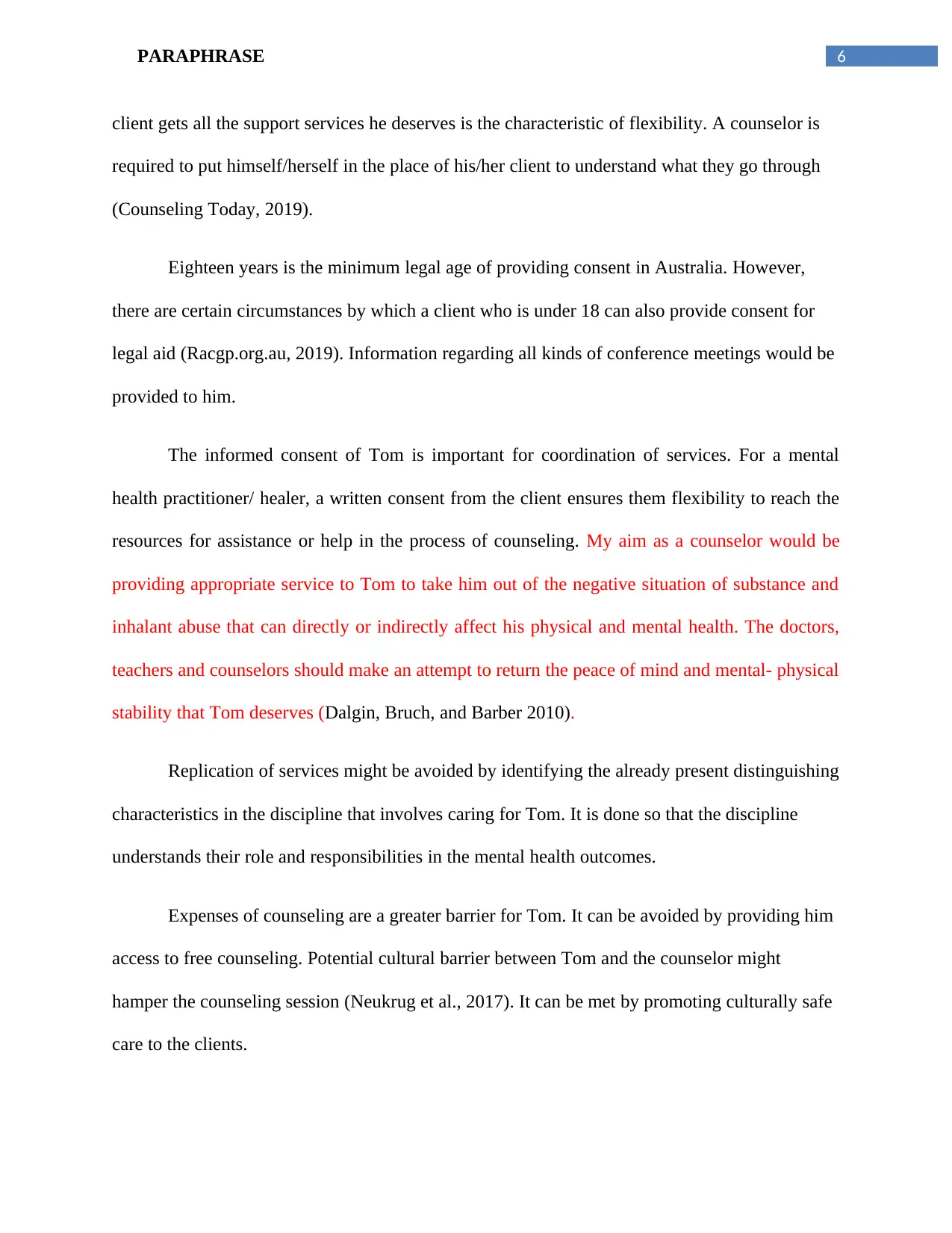
6PARAPHRASE
client gets all the support services he deserves is the characteristic of flexibility. A counselor is
required to put himself/herself in the place of his/her client to understand what they go through
(Counseling Today, 2019).
Eighteen years is the minimum legal age of providing consent in Australia. However,
there are certain circumstances by which a client who is under 18 can also provide consent for
legal aid (Racgp.org.au, 2019). Information regarding all kinds of conference meetings would be
provided to him.
The informed consent of Tom is important for coordination of services. For a mental
health practitioner/ healer, a written consent from the client ensures them flexibility to reach the
resources for assistance or help in the process of counseling. My aim as a counselor would be
providing appropriate service to Tom to take him out of the negative situation of substance and
inhalant abuse that can directly or indirectly affect his physical and mental health. The doctors,
teachers and counselors should make an attempt to return the peace of mind and mental- physical
stability that Tom deserves (Dalgin, Bruch, and Barber 2010).
Replication of services might be avoided by identifying the already present distinguishing
characteristics in the discipline that involves caring for Tom. It is done so that the discipline
understands their role and responsibilities in the mental health outcomes.
Expenses of counseling are a greater barrier for Tom. It can be avoided by providing him
access to free counseling. Potential cultural barrier between Tom and the counselor might
hamper the counseling session (Neukrug et al., 2017). It can be met by promoting culturally safe
care to the clients.
client gets all the support services he deserves is the characteristic of flexibility. A counselor is
required to put himself/herself in the place of his/her client to understand what they go through
(Counseling Today, 2019).
Eighteen years is the minimum legal age of providing consent in Australia. However,
there are certain circumstances by which a client who is under 18 can also provide consent for
legal aid (Racgp.org.au, 2019). Information regarding all kinds of conference meetings would be
provided to him.
The informed consent of Tom is important for coordination of services. For a mental
health practitioner/ healer, a written consent from the client ensures them flexibility to reach the
resources for assistance or help in the process of counseling. My aim as a counselor would be
providing appropriate service to Tom to take him out of the negative situation of substance and
inhalant abuse that can directly or indirectly affect his physical and mental health. The doctors,
teachers and counselors should make an attempt to return the peace of mind and mental- physical
stability that Tom deserves (Dalgin, Bruch, and Barber 2010).
Replication of services might be avoided by identifying the already present distinguishing
characteristics in the discipline that involves caring for Tom. It is done so that the discipline
understands their role and responsibilities in the mental health outcomes.
Expenses of counseling are a greater barrier for Tom. It can be avoided by providing him
access to free counseling. Potential cultural barrier between Tom and the counselor might
hamper the counseling session (Neukrug et al., 2017). It can be met by promoting culturally safe
care to the clients.
Paraphrase This Document
Need a fresh take? Get an instant paraphrase of this document with our AI Paraphraser
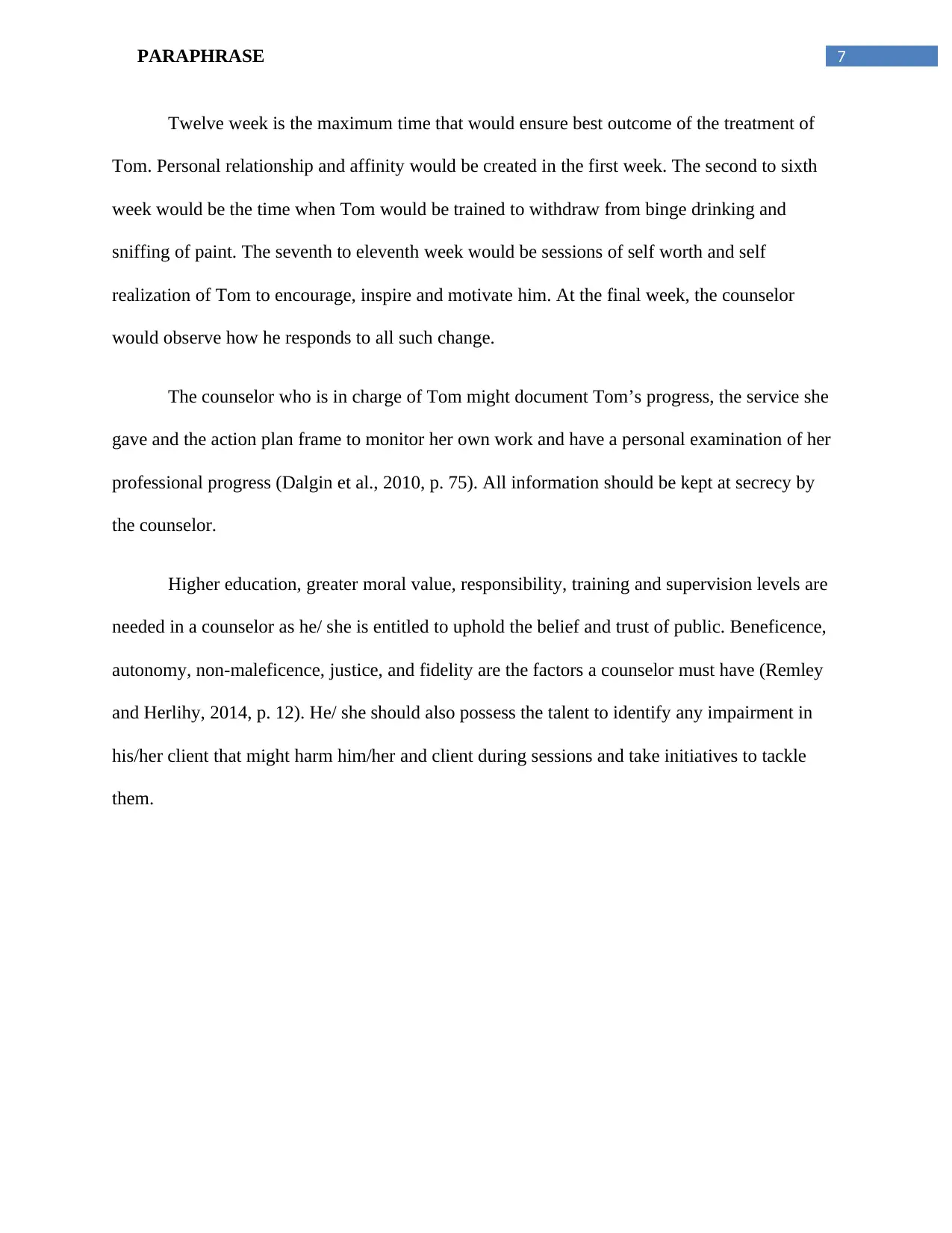
7PARAPHRASE
Twelve week is the maximum time that would ensure best outcome of the treatment of
Tom. Personal relationship and affinity would be created in the first week. The second to sixth
week would be the time when Tom would be trained to withdraw from binge drinking and
sniffing of paint. The seventh to eleventh week would be sessions of self worth and self
realization of Tom to encourage, inspire and motivate him. At the final week, the counselor
would observe how he responds to all such change.
The counselor who is in charge of Tom might document Tom’s progress, the service she
gave and the action plan frame to monitor her own work and have a personal examination of her
professional progress (Dalgin et al., 2010, p. 75). All information should be kept at secrecy by
the counselor.
Higher education, greater moral value, responsibility, training and supervision levels are
needed in a counselor as he/ she is entitled to uphold the belief and trust of public. Beneficence,
autonomy, non-maleficence, justice, and fidelity are the factors a counselor must have (Remley
and Herlihy, 2014, p. 12). He/ she should also possess the talent to identify any impairment in
his/her client that might harm him/her and client during sessions and take initiatives to tackle
them.
Twelve week is the maximum time that would ensure best outcome of the treatment of
Tom. Personal relationship and affinity would be created in the first week. The second to sixth
week would be the time when Tom would be trained to withdraw from binge drinking and
sniffing of paint. The seventh to eleventh week would be sessions of self worth and self
realization of Tom to encourage, inspire and motivate him. At the final week, the counselor
would observe how he responds to all such change.
The counselor who is in charge of Tom might document Tom’s progress, the service she
gave and the action plan frame to monitor her own work and have a personal examination of her
professional progress (Dalgin et al., 2010, p. 75). All information should be kept at secrecy by
the counselor.
Higher education, greater moral value, responsibility, training and supervision levels are
needed in a counselor as he/ she is entitled to uphold the belief and trust of public. Beneficence,
autonomy, non-maleficence, justice, and fidelity are the factors a counselor must have (Remley
and Herlihy, 2014, p. 12). He/ she should also possess the talent to identify any impairment in
his/her client that might harm him/her and client during sessions and take initiatives to tackle
them.
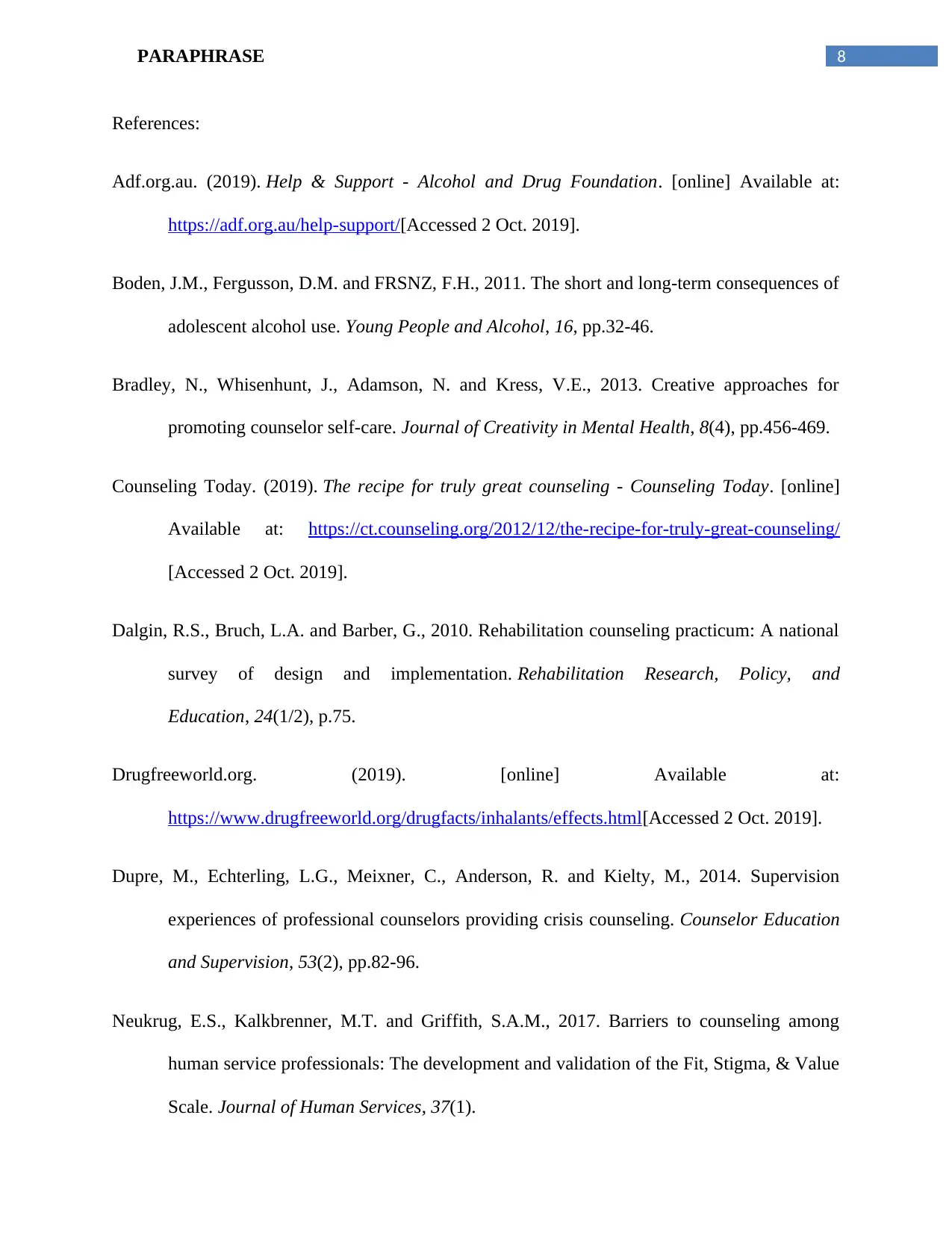
8PARAPHRASE
References:
Adf.org.au. (2019). Help & Support - Alcohol and Drug Foundation. [online] Available at:
https://adf.org.au/help-support/[Accessed 2 Oct. 2019].
Boden, J.M., Fergusson, D.M. and FRSNZ, F.H., 2011. The short and long-term consequences of
adolescent alcohol use. Young People and Alcohol, 16, pp.32-46.
Bradley, N., Whisenhunt, J., Adamson, N. and Kress, V.E., 2013. Creative approaches for
promoting counselor self-care. Journal of Creativity in Mental Health, 8(4), pp.456-469.
Counseling Today. (2019). The recipe for truly great counseling - Counseling Today. [online]
Available at: https://ct.counseling.org/2012/12/the-recipe-for-truly-great-counseling/
[Accessed 2 Oct. 2019].
Dalgin, R.S., Bruch, L.A. and Barber, G., 2010. Rehabilitation counseling practicum: A national
survey of design and implementation. Rehabilitation Research, Policy, and
Education, 24(1/2), p.75.
Drugfreeworld.org. (2019). [online] Available at:
https://www.drugfreeworld.org/drugfacts/inhalants/effects.html[Accessed 2 Oct. 2019].
Dupre, M., Echterling, L.G., Meixner, C., Anderson, R. and Kielty, M., 2014. Supervision
experiences of professional counselors providing crisis counseling. Counselor Education
and Supervision, 53(2), pp.82-96.
Neukrug, E.S., Kalkbrenner, M.T. and Griffith, S.A.M., 2017. Barriers to counseling among
human service professionals: The development and validation of the Fit, Stigma, & Value
Scale. Journal of Human Services, 37(1).
References:
Adf.org.au. (2019). Help & Support - Alcohol and Drug Foundation. [online] Available at:
https://adf.org.au/help-support/[Accessed 2 Oct. 2019].
Boden, J.M., Fergusson, D.M. and FRSNZ, F.H., 2011. The short and long-term consequences of
adolescent alcohol use. Young People and Alcohol, 16, pp.32-46.
Bradley, N., Whisenhunt, J., Adamson, N. and Kress, V.E., 2013. Creative approaches for
promoting counselor self-care. Journal of Creativity in Mental Health, 8(4), pp.456-469.
Counseling Today. (2019). The recipe for truly great counseling - Counseling Today. [online]
Available at: https://ct.counseling.org/2012/12/the-recipe-for-truly-great-counseling/
[Accessed 2 Oct. 2019].
Dalgin, R.S., Bruch, L.A. and Barber, G., 2010. Rehabilitation counseling practicum: A national
survey of design and implementation. Rehabilitation Research, Policy, and
Education, 24(1/2), p.75.
Drugfreeworld.org. (2019). [online] Available at:
https://www.drugfreeworld.org/drugfacts/inhalants/effects.html[Accessed 2 Oct. 2019].
Dupre, M., Echterling, L.G., Meixner, C., Anderson, R. and Kielty, M., 2014. Supervision
experiences of professional counselors providing crisis counseling. Counselor Education
and Supervision, 53(2), pp.82-96.
Neukrug, E.S., Kalkbrenner, M.T. and Griffith, S.A.M., 2017. Barriers to counseling among
human service professionals: The development and validation of the Fit, Stigma, & Value
Scale. Journal of Human Services, 37(1).
⊘ This is a preview!⊘
Do you want full access?
Subscribe today to unlock all pages.

Trusted by 1+ million students worldwide

9PARAPHRASE
Nystul, M.S., 2015. Introduction to counseling: An art and science perspective. Sage
Publications.
Pompeo, A.M. and Levitt, D.H., 2014. A path of counselor self‐awareness. Counseling and
Values, 59(1), pp.80-94.
Racgp.org.au. (2019). Consent to medical treatment: the mature minor. [online] Available at:
https://www.racgp.org.au/download/documents/AFP/2011/March/201103bird.pdf#target
Text=The%20age%20at%20which%20a,to%20their%20own%20medical%20treatment.
[Accessed 2 Oct. 2019].
Raval, H. and Tribe, R., 2014. Working with interpreters in mental health. Routledge.
Remley, T.P. and Herlihy, B., 2014. Ethical, legal, and professional issues in counseling. Upper
Saddle River, NJ: Pearson.
Reynolds, A.L., 2011. Counseling and helping skills. Student services: A handbook for the
profession, 5, pp.61-79.
Shendurnikar, N. and Thakkar, P.A., 2013. Communication skills to ensure patient
satisfaction. The Indian Journal of Pediatrics, 80(11), pp.938-943.
Wagner, C.C., 2012. Client-centered direction: Or how to get there when you’re not sure where
you’re going. Motivational Interviewing: Training, Research, Implementation,
Practice, 1(1), pp.36-38.
Weger Jr, H., Castle Bell, G., Minei, E.M. and Robinson, M.C., 2014. The relative effectiveness
of active listening in initial interactions. International Journal of Listening, 28(1), pp.13-
31.
Nystul, M.S., 2015. Introduction to counseling: An art and science perspective. Sage
Publications.
Pompeo, A.M. and Levitt, D.H., 2014. A path of counselor self‐awareness. Counseling and
Values, 59(1), pp.80-94.
Racgp.org.au. (2019). Consent to medical treatment: the mature minor. [online] Available at:
https://www.racgp.org.au/download/documents/AFP/2011/March/201103bird.pdf#target
Text=The%20age%20at%20which%20a,to%20their%20own%20medical%20treatment.
[Accessed 2 Oct. 2019].
Raval, H. and Tribe, R., 2014. Working with interpreters in mental health. Routledge.
Remley, T.P. and Herlihy, B., 2014. Ethical, legal, and professional issues in counseling. Upper
Saddle River, NJ: Pearson.
Reynolds, A.L., 2011. Counseling and helping skills. Student services: A handbook for the
profession, 5, pp.61-79.
Shendurnikar, N. and Thakkar, P.A., 2013. Communication skills to ensure patient
satisfaction. The Indian Journal of Pediatrics, 80(11), pp.938-943.
Wagner, C.C., 2012. Client-centered direction: Or how to get there when you’re not sure where
you’re going. Motivational Interviewing: Training, Research, Implementation,
Practice, 1(1), pp.36-38.
Weger Jr, H., Castle Bell, G., Minei, E.M. and Robinson, M.C., 2014. The relative effectiveness
of active listening in initial interactions. International Journal of Listening, 28(1), pp.13-
31.
Paraphrase This Document
Need a fresh take? Get an instant paraphrase of this document with our AI Paraphraser

10PARAPHRASE
1 out of 11
Related Documents
Your All-in-One AI-Powered Toolkit for Academic Success.
+13062052269
info@desklib.com
Available 24*7 on WhatsApp / Email
![[object Object]](/_next/static/media/star-bottom.7253800d.svg)
Unlock your academic potential
Copyright © 2020–2025 A2Z Services. All Rights Reserved. Developed and managed by ZUCOL.





